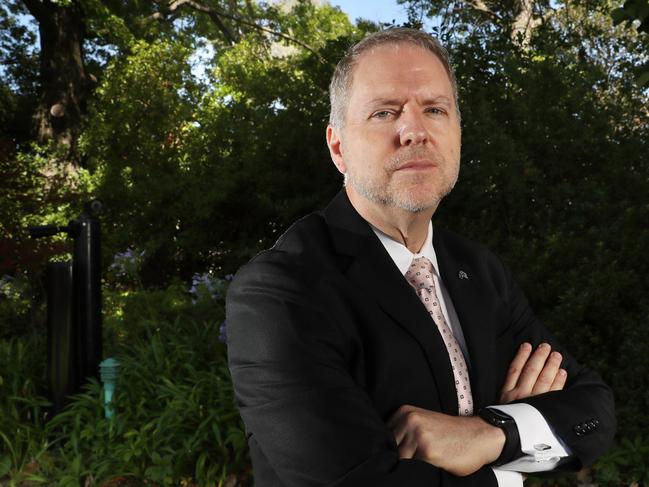Sextortion cases can quickly escalate to deadly consequences
It began with a single message. Alone in his bedroom a 17-year-old American took the bait, drawn into a flirty conversation. Hours later, he took his own life.

It began with a single message on Instagram around 10pm from an account named “dani.robertts” that simply said “hello”. Alone in his bedroom in the small town of Marquette, Michigan, 17-year-old high school senior Jordan DeMay took the bait and replied, drawn into a flirty conversation with someone he thought was an attractive teenage girl.
Just two hours later, DeMay, who was popular and had a loving family and a girlfriend, was persuaded to send an explicit photo of himself, and all friendliness from the stranger vanished in an instant. “I have screenshot all ur (your) followers. All you’ve to do is to cooperate with me and I won’t expose you. Just pay me rn (right now),” dani.robertts messaged.
Caught in a frighteningly effective scam, DeMay immediately mustered up $US300 of the $US1000 demanded. It wasn’t enough. His last message to the blackmailer as the threats continued was that he was going to “kill myself right now, because of you”.
“Good. Do that fast. Or I’ll make you do it. I swear to God,” dani.robertts replied.
In the early hours of the same morning, March 25, 2022, with his parents still in bed in the family home, DeMay took his own life.
The teenager’s tragic death highlights how quickly sexual extortion, or sextortion, can escalate to deadly consequences, and it’s not an isolated case.
A spate of suicides around the world, including in Australia, have been linked to the insidious crime – and boys and young men are most at risk.
More than 300 reports of children and teenagers being sexually extorted are being made to the Australian Federal Police every month, with experts believing only one in 10 reports it. It could mean thousands of vulnerable Australian children are being subjected to this gut-wrenching honey trap each month.
According to investigators and cyber safety experts, it’s a problem that’s spiralling fast because of difficulties in prosecuting offenders based almost exclusively overseas, and a deplorable failure of tech companies to use the tools at their disposal to stamp it out.
But they say there are things that can be done to prepare and protect kids, and to stop sextortion reaching the point of no return if it does happen.
Australia’s online safety regulator, eSafety Commissioner Julie Inman Grant, says reports of sexual extortion have “exploded” in recent years. In 2017, fewer than a quarter of reports to eSafety about image-based abuse – when someone sends or threatens to send intimate images without consent – were about sextortion. In 2022-23, sextortion accounted for almost 70 per cent of the 9060 reports.

Men and boys made up almost 90 per cent of the sexual extortion reports to eSafety, with two-thirds between the ages of 18 and 24.
Inman Grant says the susceptibility of boys and young men is probably due to them “being more likely to take risks online, coupled with the fact they are less likely to seek help”.
In the US, authorities decided to muscle up to sextortionists after a series of shocking reports of young people such as DeMay taking their lives.
These included the suicide in July 2022 of 17-year-old Gavin Guffey, son of Republican House of Representatives member Brandon Guffey, whose family was taunted on Instagram by sextortionists in the months following his death. “Did I tell you your son begged for his life,” reads one message sent to his father with a laughing face emoji.
A major international investigation resulted in the arrest and extradition of brothers Samuel and Samson Ogoshi, 22 and 20, from Nigeria. The Ogoshis – from a churchgoing middle-class family in Lagos, the sons of a retired intelligence officer – are accused of using hacked Instagram accounts to pose as young women, blackmailing more than 100 people, including DeMay.


“I will make you regret (your) life. I will make u commit suicide. I promise you I swear,” Samuel Ogoshi, a university student, allegedly wrote to one victim.
It’s a powerful insight into what Australian children and young men and women are up against when they fall into the trap, but arresting sexual extortionists is rare.
Instead, the AFP is trying to choke the money supply by targeting bank accounts used to siphon extorted funds out of the country. Since June last year, the AFP and financial watchdog Austrac have worked together to close more than 2100 accounts linked to offshore organised criminals sexually extorting Australians as part of Operation Huntsman. The accounts were operated by “money mules”, people knowingly or unwittingly assisting in transferring victims’ funds to sextortionists overseas.
“Denying transnational organised crime groups the ability to receive funds is a key disruption effort against sextortion,” says Commander Helen Schneider, from the AFP’s Australian Centre to Counter Child Exploitation.

Despite these global efforts, the death toll continues to rise. In October, 12-year-old Carson Cleland from Prince George in British Columbia, Canada, became one of the youngest victims, taking his own life after being extorted for money on Snapchat.
Australian police say they have seen children as young as 10 ensnared. Some are being blackmailed to send details of their parents’ passports and bank accounts, and Schneider warns that the same criminal syndicates also are involved in other types of online fraud and scams.
Inman Grant says the blackmailers initially make contact with people on social media, dating sites and gaming apps.
Instagram and Snapchat are the most frequently targeted sites, she says, adding tech companies are not doing enough to stop sexual extortion.
“Many of the profile pictures and profile names used to entrap unsuspecting victims are the same, used over and over,” Inman Grant says.
“Much of the messaging related to springing the trap on targets comes from well-worn scripts used by perpetrators. Online service providers should be using technology to detect these kinds of indicators at scale. And when a user is banned, there should be robust measures to prevent re-registration, and these bans should apply across all a company’s different services.”
Interim Victims’ Commissioner for Queensland Jon Rouse says “we’ve had children in Australia take their lives as a result of this … It is as prolific an issue here as it is in any other part of the world.”
But he adds: “I don’t personally believe that there’s been an orchestrated effort to specifically target children. Scammers are targeting everybody. It’s a broad net they are casting and our kids are being caught up in it.”

Until last year, Rouse was operations manager at the ACCCE, where he realised sextortion was a growing epidemic.
“The hunting ground for the sextortionists is platforms like Instagram, where people follow, for example, influencers and unwittingly make themselves targets,” he says.
As an experiment, he created a fake Instagram account and followed golf influencer Paige Spiranac. Her sexualised content has attracted 3.9 million followers on the site. “I received about 12 immediate friend requests from accounts that were purporting to be attractive women,” Rouse says.
Each sought to initiate sexualised chats.
“I reported every one of those fake accounts to Instagram and in each case they said ‘this does not breach our terms of service’.
“I subsequently had very robust conversations with Meta (parent company of Instagram and Facebook) about this, stating ‘these are fake accounts, they have no followers, they’re using generic images and they’re using the same communication methodology. I know for a fact that you had technology to detect this kind of behaviour on Messenger 12 years ago’.”
Inman Grant advises people caught up in sextortion to immediately stop all contact with the blackmailer and to seek support.
“The message I urgently want people to hear is: Don’t pay and tell someone you trust,” she says.
“Dealing with sextortion can be deeply distressing but it’s worse on your own. Talking to someone can help you to clear your head and begin taking steps to resolve things. Do this straight away and remember you’re not in the wrong, the criminals are.
“When you pay, the scam frequently escalates into a cycle of more threats and more payments. Whereas if you don’t, perpetrators will often lose interest and invest their efforts in blackmailing someone else.”
Rouse echoes the official advice to parents of victims.
“Immediately report it. Cease any further communication with the sextorter. Secure the device. Do not delete any evidence. Then make sure you’re supporting your child, this is not their fault.”
Victims should go to eSafety for advice, or if a child is involved, contact the AFP’s ACCCE.
Support is available 24/7 through Kids Helpline on 1800 55 1800 or Lifeline on 13 11 14.








To join the conversation, please log in. Don't have an account? Register
Join the conversation, you are commenting as Logout